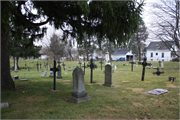| Additional Information: | During the 1860s to 1880s, many decorative wrought iron crosses were erected as burial monuments for German members of St. Mary Catholic Church in the parish cemetery, God’s Acre, at 373 W. State Street. Many of these crosses were manufactured by the Wagner foundry.
Decorative wrought iron crosses are commonly found in cemeteries throughout Germany and around the Black Sea in southern Russia. Iron cross grave markers can also be found in thousands of cemeteries across the American heartland, from Kansas to central Canada and from the Mississippi River to the Rocky Mountains. Unlike wooden crosses, those made of metal were capable of withstanding the elements over time. Wrought iron cross grave markers in the United States were used predominately by Catholics of German, Polish, and Czech heritage during the late nineteenth- and early twentieth-century. The tradition of wrought iron cemetery crosses is especially tied to the wave of German migration to the United States from the Volga region of Russia that started in the 1870s. Many Volga Germans first traveled to Wisconsin before settling in heavy concentrations in Great Plains states. Crosses were commonly homemade, while others were manufactured commercially throughout the region by blacksmith shops and foundries. Local companies known to manufacture the crosses include Badger Wire and Iron Works of Milwaukee, active during the early twentieth century, and the foundry of Hubert Wagner in Burlington, active during the late nineteenth-century. Many cross-making blacksmiths learned their trade before they immigrated to the United States during the late nineteenth-century and were from a variety of nationalities including German, Irish, Hungarian, Czech, Ukrainian, and French. Use of the wrought iron crosses waned by the end of Second World War, as tombstones of granite, marble, or concrete increased in affordability and the demand for other services of local blacksmiths declined. During the late 1980s and 1990s, wrought iron cemetery crosses in North Dakota were heavily researched and documented by the Institute of Regional Studies at North Dakota State University. This marks what appears to be the first major research conducted on the subject and recognizes the wrought iron crosses not solely as a product of a cultural group or matter of ethnic tradition, but also a as folk art form.
Wagner Foundry - Hubert Wagner partnered with Anton Zwiebel to open a machine shop and brass foundry in a wood frame building on Pine Street north of Milwaukee Avenue in 1856. The partnership dissolved in 1863, at which time Wagner continued operating the company under his own name. In 1866, the wooden machine shop was replaced with a non-extant brick building. In 1867, Wagner partnered with F. G. Klein, continuing the machine shop and iron foundry under the name Wagner & Klein. Among their products were threshing machines and fanning mill irons. In 1870, the company produced new iron window sashes for the Immaculate Conception Catholic Church on McHenry Street. In 1875, the company hired John P. Mather to set up agents for selling Wagner’s Threshing Machines in Minnesota and Iowa. Wagner constructed an office addition onto the foundry in 1876. By the 1870s, the Wagner foundry also produced wrought iron cross cemetery monuments, which can be found in an uncommonly large concentration in God’s Acre Cemetery. Under the name of Burlington Foundry & Machine Shop, the company was producing corn shellers, churns, Iron Horse Hitching Posts, cast iron sinks, and leach tubs by 1877. By 1879, Wagner bought out Klein’s interest in the company and continued again under his own name. By 1881, the company was known as Hubert Wagner’s Machine Shop & Foundry and was marketing a hay and straw cutter. In 1884, Wagner’s sons, Hubert Jr., William, and John, began leasing their father’s machine shop and foundry under the name Wagner Brothers Burlington Foundry. The Brothers are known to have operated the business through the late 1890s. |
|---|
| Bibliographic References: | Christensen, Robert O., National Register Coordinator for the Michigan State Historic Preservation Office, e-mail message to Joseph R. DeRose, Survey & Registration Historian for the Wisconsin Historical Society Division of Historic Preservation & Public History, December 6, 2011.
Churchin Vrooman, Nicholas and Patrice Avon Marvin, editors. Iron Spirits. Fargo, North Dakota: North Dakota Council on the Arts, 1982.
“Edel Blacksmith Shop History.” State Historical Society of Iowa website. <http://www.iowahistory.org>
General Files. On file at the Burlington Historical Society, Burlington, Wisconsin.
Isern, Thomas D. and Kevin Nesemeier. Wrought Iron Cross Cemeteries in North Dakota-Continuing Survey, 1998-99. Fargo, North Dakota: North Dakota State University Institute for Regional Studies, 2000.
Reilly-McNellan, Mary, Columbia Cemetery Preservation Project Manager for the City of Boulder, Colorado, Department of Parks & Recreation, e-mail message to Joseph R. DeRose, Survey & Registration Historian for the Wisconsin Historical Society Division of Historic Preservation & Public History, December 5, 2011.
Winistorfer, Jo Ann. “Iron Crosses: Sentinels of the Prairie.” North Dakota Living, April 2003. |
|---|





